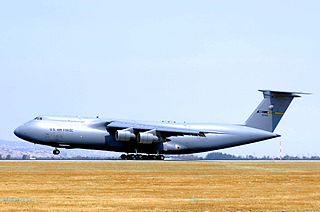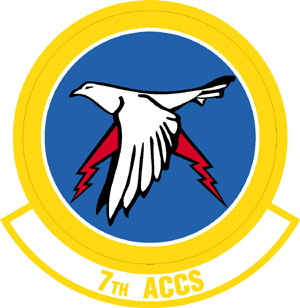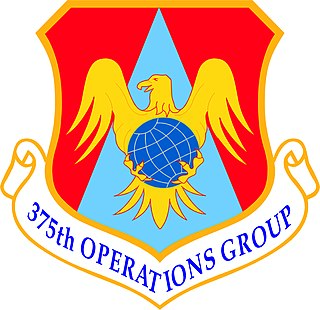
The Military Air Transport Service (MATS) is an inactive Department of Defense Unified Command. Activated on 1 June 1948, MATS was a consolidation of the United States Navy's Naval Air Transport Service (NATS) and the United States Air Force's Air Transport Command (ATC) into a single joint command. It was inactivated and discontinued on 8 January 1966, superseded by the Air Force's Military Airlift Command (MAC) as a separate strategic airlift command, and it returned shore-based Navy cargo aircraft to Navy control as operational support airlift (OSA) aircraft.

The 374th Airlift Wing is a unit of the United States Air Force assigned to Fifth Air Force. It is stationed at Yokota Air Base, Japan. It is part of Pacific Air Forces. The 374th Airlift Wing is the only airlift wing in PACAF and provides airlift support to all Department of Defense agencies in the Pacific theater of operation. It also provides transport for people and equipment throughout the Kantō Plain and the Tokyo metropolitan area.

The 60th Air Mobility Wing is the largest air mobility organization in the United States Air Force and is responsible for strategic airlift and air refueling missions around the world. It is the host unit at Travis Air Force Base in California. Wing activity is primarily focused on support in the Middle East region; however, it also maintains operations in areas of the Pacific and Indian Oceans.

The 7th Airlift Squadron is part of the 62d Airlift Wing at McChord Air Force Base, Washington. It operates Boeing C-17 Globemaster III aircraft supporting the United States Air Force global reach mission worldwide.

The 349th Air Mobility Wing is an Air Reserve Component of the United States Air Force. It is assigned to the Fourth Air Force, Air Force Reserve Command, stationed at Travis Air Force Base, California. The 349th AMW is an associate unit of the 60th Air Mobility Wing, Air Mobility Command (AMC) and if mobilized the wing is gained by AMC.

The 21st Airlift Squadron is part of the 60th Air Mobility Wing at Travis Air Force Base, California. It operates C-17 Globemaster III aircraft carrying out United States Air Force global transport missions, duties which involve airlift and airdrop missions as well as provision of services and support in order to promote quality of life for both soldiers and civilians in situations requiring humanitarian aid.

The 36th Airlift Squadron is an airlift squadron of the United States Air Force. It is part of the 374th Operations Group at Yokota Air Base, Japan.

The 56th Air Refueling Squadron is an active unit of the United States Air Force. It is part of the 97th Operations Group at Altus Air Force Base, Oklahoma. It operates Boeing KC-46 Pegasus aircraft, conducting initial and advanced aircrew training for air refueling operations.

The 459th Airlift Squadron is part of the 374th Airlift Wing at Yokota Air Base, Japan. It operates the UH-1N Iroquois and the C-12J Huron aircraft, performing passenger transport, aeromedical evacuation and search and rescue missions.

The 815th Airlift Squadron is a flying unit of the United States Air Force assigned to the Air Force Reserve Command and part of the 403d Wing at Keesler Air Force Base, Mississippi. It operates Lockheed C-130J Hercules aircraft providing global airlift.

The 19th Airlift Squadron is an inactive United States Air Force unit. It was last assigned to the 60th Operations Group, Travis Air Force Base, California. The last sortie was flown on 2 August 1996 and the unit inactivated effective 30 September 1996.

The 7th Expeditionary Airborne Command and Control Squadron is part of the 379th Air Expeditionary Wing at Al Udeid Air Base, Qatar. It operates the E-8 Joint STARS aircraft, conducting airborne command and control missions. The squadron has performed the airborne command and control mission since 1968, when it was activated in Vietnam. In 1985, the squadron was consolidated with three earlier units: The 7th Ferrying Squadron, which helped deliver aircraft to the Soviet Union from 1942 until 1944; the 7th Combat Cargo Squadron, which performed combat airlift missions in the Southwest Pacific Theater from 1944 until V-J Day, then became part of the Occupation Forces in Japan until inactivating in 1948; and the 7th Air Transport Squadron, Special, which provided airlift support for the United States' special weapons program from 1954 to 1966.

The 60th Operations Group is a United States Air Force unit assigned to the 60th Air Mobility Wing. It is stationed at Travis Air Force Base, California.

The 316th Operations Group is the flying component of the Air Force District of Washington 316th Wing, stationed at Andrews Air Force Base, Maryland. It provides rotary-wing contingency response support capability to the United States National Capital Region while also supporting regional and global customers with critical airfield infrastructure and aviation services. The group consists of two squadrons of aircrew and support personnel.

The 375th Operations Group is the operational flying component of the United States Air Force 375th Air Mobility Wing. It is stationed at Scott Air Force Base, Illinois.

The 374th Operations Group is the operational flying component of the United States Air Force 374th Airlift Wing. It is stationed at Yokota Air Base, Japan.

The 776th Expeditionary Airlift Squadron is a provisional United States Air Force squadron activated after 11 September 2001, being engaged in the Global War on Terrorism. Its current status is not publicly known.

The 65th Military Airlift Support Group is an inactive unit of the United States Air Force. It was last active as part of Military Airlift Command at Yokota Air Base, Japan, where it was inactivated on 1 June 1972.

The 317th Operations Group is an inactive United States Air Force unit, last stationed at Pope Air Force Base, North Carolina as part of Air Mobility Command. It was activated in 1992 during the Air Force's Objective Wing reorganization, and inactivated the following year when all Air Force units at Pope were assigned to the 23d Wing.

The 55th Airlift Flight is an inactive unit of the United States Air Force, last stationed at Osan Air Base, South Korea. It was inactivated in 2007.




























